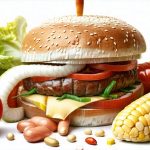The modern Western diet, often prioritizing convenience and palatability, has inadvertently contributed to a surprising digestive issue: constipation stemming from excessive consumption of smooth, soft foods. While seemingly counterintuitive – surely easy-to-digest food would promote regularity? – this phenomenon is becoming increasingly common. It’s not about avoiding these foods entirely; rather, it’s about understanding how an overreliance on them can weaken the digestive system’s natural mechanisms for moving waste through the body. We often associate constipation with a lack of fiber, and rightfully so, but the issue isn’t always about what’s missing, but also about what’s lacking in stimulus for optimal gut function.
This is particularly relevant as we age, but can affect people of all ages who consistently favor processed foods, refined grains, yogurt, applesauce, mashed potatoes, and other easily digestible options. These foods require minimal effort from the digestive system to break down, leading to a decline in peristalsis – the wave-like muscle contractions that propel food through the intestines. Essentially, the gut “gets lazy” because it’s not being challenged enough. This creates a vicious cycle where less stimulation leads to slower transit time and ultimately, constipation. It’s important to remember that digestion isn’t just about breaking down food; it’s also about movement within the digestive tract.
The Role of Mechanical Stimulation
The human digestive system evolved over millennia to process foods requiring significant physical breakdown. Our ancestors didn’t have access to blenders or pre-chewed, soft textures. They consumed fibrous roots, tough meats, and whole grains that demanded substantial chewing and robust intestinal contractions to move along the digestive tract. This constant mechanical stimulation was crucial for maintaining a healthy gut motility. Smooth, soft foods bypass much of this necessary stimulation. – They require less chewing, reducing the initial physical breakdown. – They are easier for the stomach to process, requiring less churning action. – And crucially, they travel through the intestines with minimal resistance, providing little stimulus for peristalsis.
Over time, this lack of mechanical stimulation can weaken the intestinal muscles, much like any muscle that isn’t regularly exercised. The colon becomes less responsive and efficient at moving waste along. Think of it like a rubber band stretched repeatedly; eventually, it loses its elasticity. This isn’t to say soft foods are inherently bad – they have their place, especially for individuals with certain digestive conditions or after surgery – but they shouldn’t constitute the bulk of one’s diet. A balanced approach, incorporating both soft and textured foods, is key. The absence of texture also impacts the microbiome. Fiber isn’t just about bulk; it provides food for beneficial gut bacteria which thrive on complexity. Smooth foods often lack this crucial element, potentially contributing to an imbalance in the gut flora. Understanding gas from certain foods can also help pinpoint dietary triggers.
The consequence isn’t simply constipation, but a broader disruption of digestive health. When waste lingers in the colon for extended periods, it can lead to increased water absorption, making stools harder and more difficult to pass. It also increases the risk of bacterial overgrowth and toxin reabsorption. This is why chronic constipation has been linked to various health issues beyond just discomfort, including bloating, fatigue, and even mood disturbances. Addressing this issue requires a conscious effort to reinstate mechanical stimulation through dietary changes and lifestyle adjustments. You may wonder about tests doctors use to differentiate between gas and inflammation.
Reintroducing Texture & Fiber Gradually
The key to overcoming constipation caused by smooth food overuse isn’t a sudden overhaul of your diet, but rather a gradual reintroduction of texture and fiber. Abruptly increasing fiber intake can actually worsen symptoms initially, leading to bloating and discomfort. It’s about retraining the digestive system, not shocking it. Here’s a phased approach: 1. Start small: Begin by adding one textured food per day. This could be a handful of berries with your yogurt instead of just plain yogurt, or a side of steamed broccoli with your mashed potatoes. 2. Focus on whole foods: Prioritize naturally fibrous foods like fruits and vegetables with their skins (when appropriate), whole grains, legumes, nuts, and seeds. 3. Increase chewing: Consciously chew your food more thoroughly. This aids in the initial breakdown process and stimulates digestive enzymes.
Consider incorporating foods that provide a natural “scrubbing” effect within the intestines. Chia seeds and flaxseeds are excellent examples – their small size and slightly rough texture help to clean the intestinal walls as they move through the digestive system. Similarly, fruits with edible skins like pears and apples offer both fiber and gentle scrubbing action. It’s also worth exploring different cooking methods. Roasting vegetables instead of boiling them can retain more fiber and create a firmer texture. Remember that hydration is paramount. Fiber absorbs water, so drinking plenty of fluids (water, herbal tea) is essential to prevent stools from becoming hard and difficult to pass. Incorporating bitter foods can further support digestive health.
The Importance of Physical Activity
While dietary changes are crucial, physical activity plays a significant role in promoting gut motility. Exercise stimulates the muscles in your digestive tract, helping to move waste along more efficiently. It doesn’t need to be strenuous; even moderate exercise like walking, swimming, or yoga can make a substantial difference. – Regular movement: Aim for at least 30 minutes of moderate-intensity exercise most days of the week. – Core strengthening exercises: Exercises that strengthen your core muscles can also support digestive function. – Mindful movement: Practices like yoga and tai chi can promote relaxation and reduce stress, which can contribute to constipation.
Stress is a major contributor to digestive issues. When you’re stressed, your body diverts energy away from non-essential functions like digestion. This can slow down peristalsis and lead to constipation. Incorporating stress-reducing techniques into your routine – such as meditation, deep breathing exercises, or spending time in nature – can help to restore balance and improve digestive health. Think of the gut as a sensitive system easily disrupted by both physical inactivity and emotional distress. GERD and yawning can also impact breathing which affects stress levels.
Addressing Underlying Issues & Seeking Support
If dietary and lifestyle changes aren’t sufficient to alleviate constipation, it’s important to consider underlying issues that may be contributing to the problem. While this article avoids giving medical advice, certain conditions – such as irritable bowel syndrome (IBS), thyroid disorders, or medication side effects – can cause or exacerbate constipation. It’s essential to consult with a healthcare professional to rule out any underlying medical causes and receive appropriate treatment. – Keep a food diary: Track what you eat and when you experience symptoms to identify potential triggers. – Monitor your hydration levels: Ensure you’re drinking enough fluids throughout the day. – Listen to your body: Pay attention to signals of fullness and avoid overeating.
Don’t hesitate to seek support from a registered dietitian or other healthcare professional who can provide personalized guidance on dietary changes and lifestyle adjustments. They can help you create a plan that addresses your specific needs and preferences. Remember, overcoming constipation is often a process that requires patience, consistency, and self-compassion. It’s about building sustainable habits that support long-term digestive health. Focusing on whole foods, mechanical stimulation, physical activity, stress management, and seeking professional guidance when needed are all essential steps towards restoring regular bowel movements and improving overall well-being. Long-term antacid use can impact nutrient absorption, so be mindful of that as well. Consider if a standing desk could help with overall wellbeing too. Finally, remember to discuss any concerns about vitamin deficiencies from PPI use with your doctor.


















